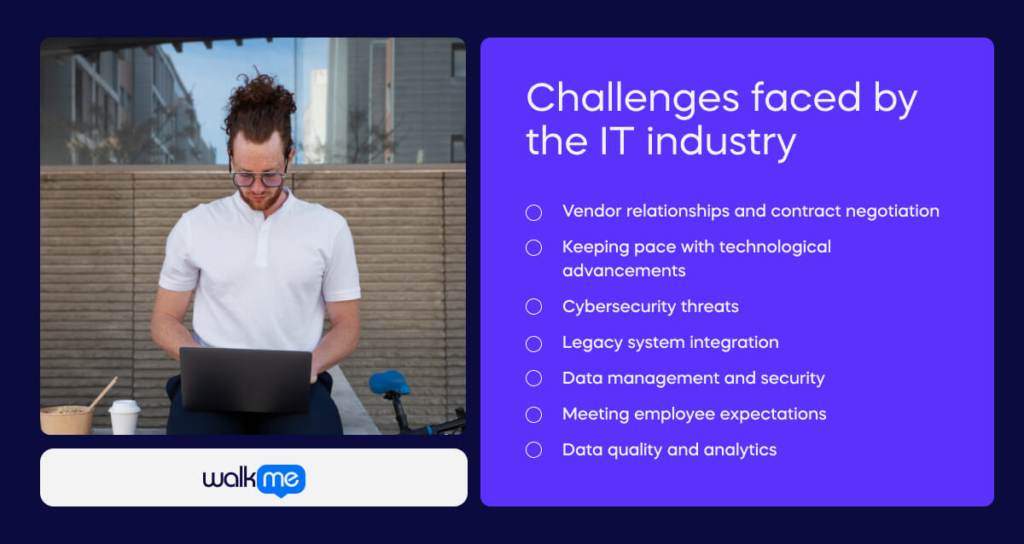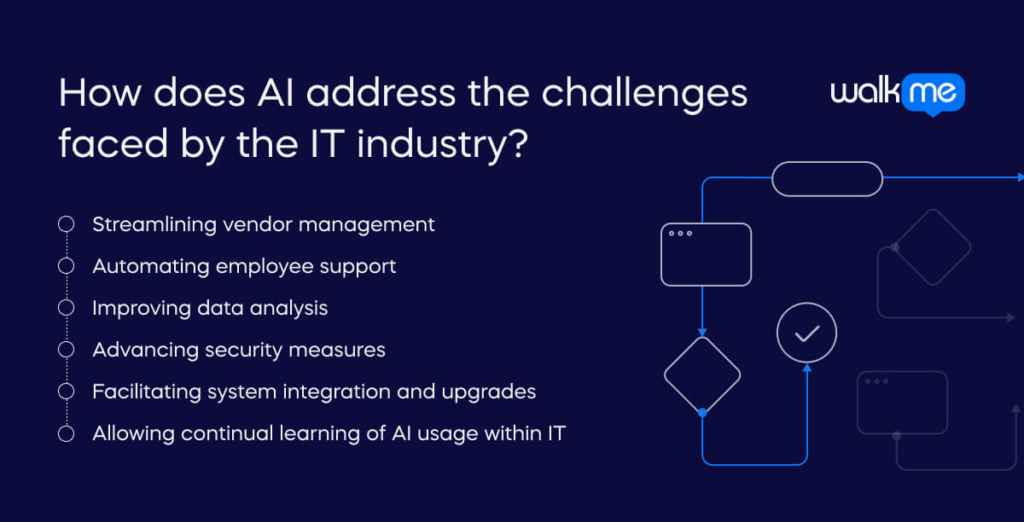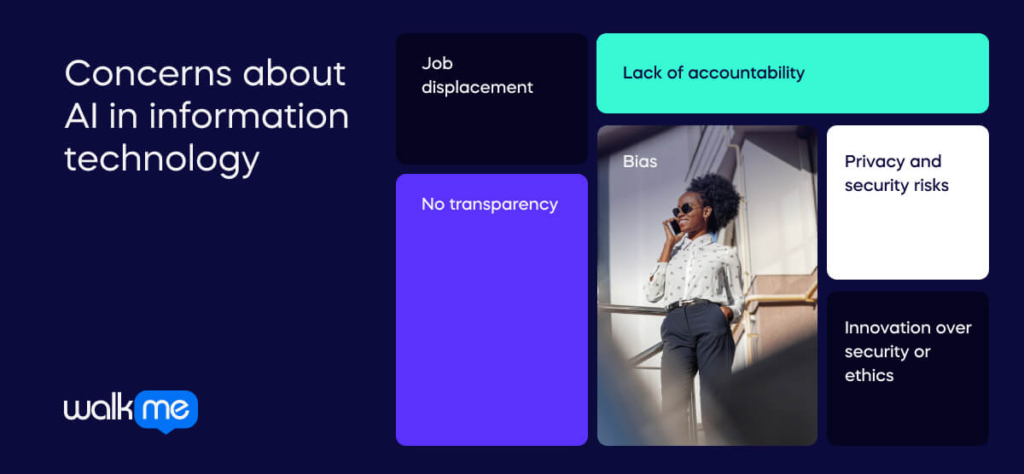Industries are continually digitizing. This pushes IT companies to adapt quickly to increasing complexities and technology-driven advancements. They need to drive innovation while managing the limitations of outdated infrastructures. As IT infrastructures and client demands become more complex, you need better management solutions.
Artificial intelligence has emerged as a pivotal solution in this evolving landscape. It’s capable of performing tasks that mimic human actions. This includes recognizing speech and text. Moreover, AI solves problems by processing vast amounts of data to identify patterns.
This article explores the role of AI in the IT industry as well as the benefits and concerns of using it. Next, it looks at how AI can solve the challenges of the IT industry and its various use cases. Lastly, it teaches you how to put in place AI for IT and looks at what the future holds for this industry.
What is the role of AI in the information technology industry? (Overview)
AI’s role within the information technology industry is to enable computers to perform tasks that would typically need human intervention. This technology uses computer-based learning and algorithms. As a result, AI and machine learning create systems that can imitate human behavior.
Take, for example, an AI system designated for overseeing network operations. It can swiftly pinpoint anomalies. This prompts the IT team to take swift action against potential threats. This proactive approach helps in averting large disruptions or possible harm.
Moreover, AI-powered platforms improve customer service by providing help around the clock. They autonomously manage routine tasks, such as resetting passwords or fetching information. It can elevate more complex cases to human staff, ensuring uninterrupted and effective support.
The adaptive learning feature of AI systems signifies their ability to continually evolve. They fine-tune their responses by learning from previous engagements. This accelerates issue resolution and cultivates a more customized customer experience. As the system gets more information from each customer interaction, it changes its approach to match user preferences.
Challenges faced by the IT industry

The various challenges faced by the IT industry include:
Vendor relationships and contract negotiation
Managing relationships with IT vendors effectively is critical. Negotiating contracts and ensuring that service levels meet expectations are challenging tasks. The IT services industry operates in a fast-paced environment. New technologies emerge continuously, requiring diligent oversight and strategic foresight in vendor partnerships.
Keeping pace with technological advancements
The rapid evolution of technology demands continuous learning and adaptation. Advancements in AI, cloud computing, IoT, and cybersecurity are notable examples. IT service providers must commit large resources to research and development. This commitment is essential to deliver solutions that meet the dynamic needs of clients.
Cybersecurity threats
The IT industry faces evolving cyber threats. These include malware, ransomware, phishing attacks, and zero-day vulnerabilities. Staying ahead of these threats is formidable. It requires ongoing vigilance and innovative security strategies.
Legacy system integration
Many IT firms undertake the integration of legacy systems with modern technologies. This process is complex and presents significant challenges. Firms must balance the need for new functionalities with the limitations of existing systems.
Data management and security
The exponential growth of data brings challenges in management and security. Prioritizing data privacy is crucial. Complying with regulations and protecting against data breaches and cyberattacks are top concerns. These tasks are ongoing for IT service providers.
Meeting employee expectations
Employees today have high expectations from IT teams. They expect customized, innovative, and scalable solutions. These solutions must align with their business objectives. Customers demand quick response times, end-to-end services, and continuous support. Meeting these expectations requires providers to be agile, adaptable, and customer centric.
Data quality and analytics
Ensuring data quality and leveraging data analytics are critical tasks. Organizations face the challenge of navigating large volumes of data. They must extract actionable insights and drive strategic initiatives. This necessity demands sophisticated analytical capabilities and a deep understanding of business needs.
How does AI address the challenges faced by the IT industry?

While there are several IT industry challenges, AI can address them by:
Streamlining vendor management
AI can revolutionize vendor management by automating contract analysis and negotiations. Through predictive analytics, it’s possible to assess vendor performance. Such advancements save time and enhance the accuracy and efficiency of managing vendors.
Automating employee support
You can equip AI-driven chatbots and virtual assistants to handle routine queries from employees. This allocation allows human agents to focus on more complex problems. These AI solutions ensure employees have constant access to support. This boosts satisfaction and support quality.
Improving data analysis
Machine learning algorithms and predictive analytics can drastically speed up data analysis. These technologies aid in identifying patterns and deriving insights. So, they help make decisions based on data-driven conclusions. This analysis is vital for keeping a competitive edge and making informed decisions.
Advancing security measures
AI improves upon traditional fraud detection by learning from a company’s historical data. It can recognize patterns indicative of fraud. This enables real-time detection and prevention of fraudulent activities. AI systems track user behavior to spot anomalies that could signify suspicious activities. This improves security measures.
Facilitating system integration and upgrades
AI simplifies the integration of legacy systems with modern technologies. Machine learning is instrumental in understanding and mapping legacy application architectures. This automation streamlines the integration process, making system upgrades more efficient.
Allowing continual learning of AI usage within IT
AI equips IT professionals with competitive tools. These include machine learning, computer vision, deep learning, and NLP. These technologies can analyze market trends and provide concise reports with actionable insights.
Additionally, AI can automate routine tasks. It also offers personalized learning paths through AI-based training systems. This support allows IT professionals to concentrate on complex issues. It also allows them to stay updated on the latest technological advancements.
Benefits of AI in information technology

The most common benefits of AI in information technology are:
Predictive maintenance
Artificial Intelligence (AI) can identify software and hardware failures. It analyzes data patterns to predict these failures before they happen. This ability enables proactive maintenance. As a result, this reduces unplanned downtime and related costs. This enhances operational efficiency.
Cybersecurity
With cyber threats becoming ever more intricate, AI’s critical role in detecting and neutralizing security threats grows. It uses network analysis to spot and react to security anomalies. This strategic use of AI in cybersecurity strengthens organizational defenses. It ensures the protection of sensitive data and digital frameworks.
Cost savings
AI contributes to reducing operational costs within IT departments. It does this by automating tasks, minimizing downtime, and optimizing resource distribution. The efficiency of streamlined processes allows for more effective resource use. This offers significant cost advantages to organizations.
Reduction of the workload on IT support
AI impacts IT through natural language processing (NLP) and chatbot technology. This technology allows more useful interactions between users and computers. AI-driven chatbots can converse with users, respond to inquiries, and offer help.
This revolutionizes customer service by handling diverse questions. It also provides instant answers, and gives customized suggestions. It improves customer satisfaction and reduces the workload on human support teams.
Enhanced employee experience
AI improves the employee experience. It does this through user personalization, chatbots, and automated self-service solutions. Additionally, AI uses advanced algorithms and machine learning to enhance security. It identifies potential threats and gives solutions to mitigate system vulnerabilities.
Improved compliance and governance
AI can also assist in monitoring and auditing IT operations. This ensures adherence to industry regulations and governance protocols. AI minimizes the risk of false positives. It also ensures that employees follow compliance procedures. This contributes to a more secure and compliant operational environment.
Lower human errors
AI-driven automation reduces the burden of repetitive tasks. This leads to significant cost savings and reduces the need for manual labor. Deep learning allows IT departments to automate backend processes. Over time, AI-enabled systems learn from past errors, improving their effectiveness.
Enhanced IT infrastructure
AI enhances IT infrastructure by managing server and data center operations. Through dynamic resource allocation and predictive analytics, AI maximizes efficiency. This reduces energy costs and supporting sustainability efforts.
Real-time analytics
AI provides real-time analytics on user behavior, system performance, and software. This offers valuable insights and frees up time for strategic decision-making. Instant access to data analytics supports informed responses to trends and challenges.
Better workforce productivity
AI aids IT professionals in troubleshooting and decision-making. This enhances workforce productivity. By automating routine tasks, AI enables IT teams to focus on strategic projects and complex problem-solving. This leads to more efficient and effective operations.
Concerns about AI in information technology

Awareness of the concerns of using AI in the IT industry is important.
These are:
Job displacement
A significant concern within the IT industry of the adoption of artificial intelligence (AI) is the fear of job obsolescence. This worry is partly justified. This is the case for tasks that involve analyzing large data sets. Advanced AI can outperform humans in certain functions. This is because it does not need rest. It can also operate with speed and efficiency beyond human capabilities.
Bias
Machine learning algorithms can develop biases based on the data they are trained with. These biases can lead to skewed, and sometimes unfair, outcomes. The unintentional introduction of bias raises ethical concerns and challenges.
Lack of accountability
With the increasing integration of AI tools within the IT industry, determining responsibility for negative outcomes becomes harder. Should companies should verify the algorithms of AI tools they buy? Or should we hold the creators of the AI tools responsible? This ambiguity complicates accountability, making it challenging to pinpoint responsibility for adverse results.
No transparency
AI systems are sometimes developed without prioritizing transparency, inclusivity, or sustainability. This lack of transparency can obscure the reasoning behind potentially harmful AI decisions. This then adversely affects users and businesses. Ensuring AI is developed ethically and responsibly becomes a paramount concern.
Privacy and security risks
AI can enhance decision-making capabilities. But, it also raises concerns about data breaches and unauthorized access. This highlights the importance of robust security measures to protect sensitive information.
Innovation over security or ethics
Innovation can become more important than ethical considerations or security. This can result in the release of AI systems without adequate ethical design or security protocols. This exposes companies to potential risks, undermining trust in AI technologies.
Use cases of AI in information technology
AI enhances various IT operation sectors by improving productivity, efficiency, and decision-making.
Below are some of the most notable use cases in the IT industry:
Enhances data analytics
AI algorithms have transformed the field of data analytics. They can process and analyze vast amounts of data in real-time. This helps uncover valuable insights and patterns that were once hidden. This advancement enables IT teams to base their decisions on data.
It also helps them predict customer behavior accurately, and optimize their operations. As a result, organizations can maintain a competitive edge in today’s digital landscape.
Transforms enterprise architecture
AI is making significant strides in reshaping enterprise architecture (EA). Early iterations of Generative AI are already assisting with creating detailed application documentation and researching advanced successor technologies.
This frees up valuable time for EA professionals. It allows them to concentrate on more complex tasks like the design and implementation of new systems and architectures.
Furthermore, neural graph networks (GNN) and machine learning (ML) recommendation systems are being integrated into EA tools. These tools can analyze complex data and recommend the best course of action.
Advances IT security
AI has improved threat detection and prevention within IT security. By analyzing network traffic, AI algorithms can identify potential threats early. This enables IT staff to take proactive measures before any damage occurs.
For instance, AI security tools can automatically respond to threats by blocking suspicious IP addresses or quarantining infected devices. This proactive security bolsters defenses. It also reduces the workload of IT staff. This contributes to a more secure and efficient operational environment.
Revolutionizes IT support
The introduction of AI-powered chatbots and virtual assistants has revolutionized IT support services. These systems can respond to user queries, troubleshoot common issues, and provide instant help. This automation platform reduces the burden on human support teams. It leads to improved response times. It can also contribute to a more efficient and scalable IT support infrastructure.
Boosts cybersecurity
The evolving and increasingly sophisticated nature of cyber threats necessitates a robust response. AI plays a pivotal role in detecting and preventing security breaches. AI-powered systems can analyze network traffic. This process can identify patterns indicative of malicious activities. It can also respond to potential threats in real-time.
Machine learning algorithms also learn from past security incidents, making them effective in combating cyber attacks.
Automates IT operations
AIOps automates key IT operations processes such as anomaly detection, event correlation, and causality determination. This automation is crucial in managing modern IT architectures. It also helps with handling vast amounts of data generated by these systems. AIOps helps reduce the time and effort required to identify and resolve IT issues. This enhances service quality and minimizing downtime.
Transforms software development and testing
AI is making notable contributions to software development and testing. Automated code generation, bug detection, and optimization are just a few areas where AI is having a significant impact. This technological intervention accelerates the software development lifecycle. It also reduces errors, and ensures the delivery of high-quality software products to the market.
Enhances process automation
Combining AI with robotic process automation (RPA) has the potential to automate routine, rule-based tasks. This increases operational efficiency and allows staff to divide more time to strategic tasks.
Optimizes network performance
AI contributes to performance optimization by analyzing network traffic patterns. It uses algorithms to adjust network configurations to accommodate varying workloads, ensuring efficient data flow. This adaptability is essential for maintaining optimal performance in today’s dynamic IT environments.
Enhances fraud detection
AI improves the ability to detect fraud. It does this by identifying patterns and anomalies that may state fraudulent activity. Machine learning algorithms, trained on historical fraud data, can detect fraudulent transactions in real-time. This capability not only reduces financial losses but also enhances customer trust.
Personalizes user experiences
AI is instrumental in tailoring user experiences in IT applications. AI can offer personalized content recommendations by analyzing user behavior and preferences. This level of personalization leads to increased user satisfaction and engagement. This contributes to the development of more intuitive IT solutions.
How to implement AI for information technology

You can implement AI for information technology in a systematic way with these steps:
Learn more about AI
Begin by acquainting yourself with the capabilities of modern AI. Consider participating in remote workshops and online courses.
Platforms like EdX and Udacity offer introductory and advanced courses in key areas such as machine learning (ML) and predictive analytics.
Explore AI use cases
The next step involves brainstorming potential AI enhancements for your products and services. It’s crucial to pinpoint specific scenarios where AI could address business challenges or add significant value.
This phase requires setting clear objectives for AI implementation. You can focus on goals like enhancing operational efficiency and bolstering security measures. You could also consider optimizing the use of resources within your organization.
Assess readiness for AI
A thorough evaluation of your current IT infrastructure is essential. This review should cover existing technologies, the quality of your data, and the skill levels of your team. Assessing these areas will help determine how ready your organization is for AI integration.
After identifying your business needs, outline the potential business and financial benefits of your AI initiatives. Aim to connect each proposed AI implementation with concrete returns. You need to focus on near-term objectives to show financial or business value.
Understand value drivers
It’s important not to overlook key value drivers, such as enhanced employee productivity. Reflect on whether automating specific tasks with AI could ease time-consuming responsibilities. An effective AI solution should seamlessly integrate into your daily operations. It must enhance your business processes and offer long-term operational benefits.
Check organizational capability
Having a realistic understanding of your organization’s capacity to implement AI is vital. It’s essential to recognize both the technological and procedural capabilities of your organization.
Identifying gaps in your internal capabilities involves recognizing the need for acquiring new technologies or evolving existing processes. Leveraging existing projects or teams could help growth within specific business units.
Develop AI expertise
AI development is a specialized field that differs significantly from traditional software development. It requires a unique blend of skills and extensive experience to design algorithms capable of teaching machines to think, learn, and optimize business workflows.
You can also consider outsourcing this task to agencies that specialize in big data, AI, and machine learning. These agencies bring both expertise and a proven process to the table. It will help avoid common pitfalls in both planning and production phases.
Prepare data for AI
Data is the lifeblood of AI systems. Ensuring that relevant data is both accessible and available is a preliminary step. You should also look at historical performance data and other critical data sources.
The next step involves cleaning and preprocessing this data to guarantee its quality and reliability. The success of AI models relies on the quality of input data. This makes this step fundamental to the effectiveness of AI solutions.
Pilot AI projects
Start with a controlled testing environment. This allows for the assessment of how AI models perform under real-world conditions. For initial projects, a pilot phase lasting 2-3 months is often enough. This period helps maintain focus on clear, achievable goals.
Small, dedicated teams, comprising 4-5 individuals, can ensure the pilot project remains on track. Then the organization can determine the feasibility and scope of a more extensive, long-term project.
Scale AI initiatives
Successful pilot projects pave the way for broader AI integration. Check how the AI system performs with new datasets. Consider integrating the technology into everyday business operations.
Transition from low-risk, low-cost initiatives to more ambitious projects. You should learn from insights gained from early implementations. These initial experiences are invaluable for identifying scalable strategies.
Ease employee adoption
Introducing AI to help with daily tasks rather than a replacement for jobs is critical. Preparing for AI integration involves engaging with key stakeholders throughout the process. Provide comprehensive training and ongoing support to ensure a smooth transition to AI-enhanced operations.
Track and refine AI systems
Deploy monitoring tools to track AI system performance in real-time. Continuous refinement and improvement of AI models are crucial for adapting to changing business needs and maintaining a competitive edge.
Stay informed about the latest advancements in AI technologies and methodologies. Reassess your data strategy and AI solutions. This is necessary to continue delivering value and driving business growth.
Future trends of AI in information technology
The future of AI in the IT industry is shaped by various benefits and challenges. There will be more discussions around privacy and security. As AI advances, you need ongoing software development to safeguard individuals and businesses.
Coupled with these concerns are the environmental implications of AI model training. The high energy consumption of training these models shows the need for innovative and energy-efficient solutions.
Moreover, the rapid pace of AI’s development highlights the need for regulatory and ethical standards. These need to evolve alongside technological advancements. As technology changes, education remains a focal point, preparing future generations for a world dominated by AI.
Despite the hurdles, the consensus on AI’s benefits is clear. It can drive efficiency and foster innovation in the digital workplace. It can also address global challenges such as climate change and healthcare disparities.
AI’s expanding role within IT services includes handling everything from routine tech support to complex network security management. But, the demand for skilled IT professionals will remain unchanged. Their expertise is crucial for designing and managing these systems. This will ensure ethical use, and provide insights that AI cannot.
The conversation around AI also opens up to the emergence of new technologies. These include quantum computing, neuromorphic computing, and advanced robotics. This might shift the focus away from AI.
Industry giants like Google and OpenAI are expected to continue developing platforms. These platforms will allow for the customization of powerful language models. It will also include the creation of chatbots without needing coding skills.
The IT industry will further use AI to analyze comprehensive histories of omnichannel employee experiences. This includes call transcripts, emails, and CRM platforms. This analysis will help in making smarter decisions. It will also refine instructions to prevent product misuse based on AI feedback.
This continuous evolution highlights the importance of adaptability when navigating AI’s rapid advancements.
Key takeaways for AI in information technology
The adoption of artificial intelligence (AI) in information technology marks a major shift in how organizations use technology. AI enhances IT governance and improves IT operations. This highlights its broad applications in the IT field. As companies embrace these technological advances, they can stay ahead of the competition.
This ensures they maintain a competitive edge in the evolving IT landscape. The evolution of AI within IT is an ongoing process. AI is set to have an even bigger impact on IT.
It will improve system efficiency and advance data analysis. It can also offer more personalized and precise experiences for users. This progress will further drive innovation.
Organizations that adopt AI in a strategic and responsible manner will be in a strong position. They can secure a competitive advantage in the ever-evolving digital world.


